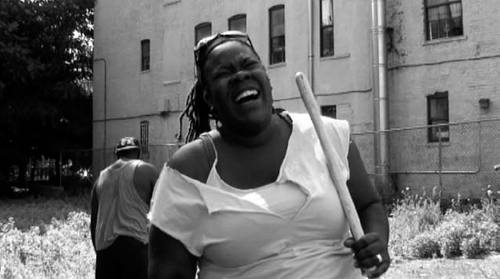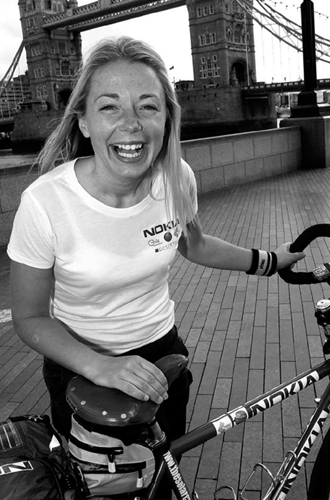The Next Eco-Warriors (31 page)
Read The Next Eco-Warriors Online
Authors: Emily Hunter

And as the guerilla garden grows, I've come to realize that we the people have every right to manifest what we want to see in our world, and no stinking bureaucrat can stop the will of the people, especially when there is food involved.
¡Viva la Libertad!

PHOTO BY FLONIA TELEGRAFI
Tanya Fields is the executive director and founder of the BLK ProjeK, a nonprofit that empowers women through urban agriculture, civic engagement, and holistic health. She is still an active member of Madres en Movimiento and is working diligently to find a permanent home for the Libertad Urban Farm. Currently, Tanya is successfully running a yoga program for underprivileged women and a farm share, bringing healthy, affordable produce to the hood
.
 Thirty
Thirty Britain
Britain Cycling Crusader
Cycling Crusader

PHOTO BY SUSIE WHEELDON
Act as if what you do makes a difference. It does
.
—WILLIAM JAMES
THE SNOW BURNED AND WHIPPED AGAINST my face as I pedaled my bicycle on, my gears and brakes freezing in the chilly climate of central China during a freak snowstorm. My temples pounded painfully from a severe headache brought on by the cold. My cycling partner and I continued our slow, arduous journey to the next stop with our heads down, our motivation buckling under the heavy snow. Regretfully, we declined ride after ride from concerned passersby, determined to reach our cycling goal of one hundred miles (160.9 kilometers) a day, until a minivan pulled up in front of us and I stopped. That was a mistake. I put one foot down briefly to tell them through chattering teeth that we weren't crazy for cycling in such weather—we were actually just crazy for cycling around the world.
Unbeknownst to me at the time was that the foot I had set down was getting covered in ice and snow along with the pedal. So as I watched the warm, safe glow of the minivan drive off in the distance, I tried to get my foot back on the pedal. I tried again and again to no avail. My toes were frostbitten, and I was at the end of my rope with only one option—pedaling the rest of the way with just one foot. We were halfway through our round-the-world cycle promoting solar power, and instead of basking in sunshine, were caught in the worst blizzards China had seen in fifty years.
What had I gotten myself into? This wasn't the first or last time I would think this in my life. Three years ago, I was in a desert, running in the Marathon des Sables held in the Moroccan Sahara, blasting my ’80s rock music in
the sweltering heat. It struck me while preparing for my run that the sun is a free power source that anyone could use. The desert would be the perfect place to try out my new Solio charger, a universal solar charger for my mp3 player. Needless to say, it was a hit among the other marathoners and the beginning of my personal love affair with solar energy.
More energy falls on the world's deserts in six hours than its population consumes in a year. Knowing this, we continue in our pursuit to promote this incredible store of potential energy
.
Upon returning home to London, I immediately started investigating a way to combine my passion for adventure with promoting a solar energy solution to climate change. For me, being an activist and making change didn't have to involve protests and petitions, because those weren't my strengths. It was thrilling instead to think about spreading awareness of solar energy in new ways while also staying true to myself.
At a friend's wedding, I approached Jamie Vining, my soon-to-be cycling partner, about doing an adventure with me, and he immediately jumped onboard. Iain Henderson, a childhood friend, was an investment banker at the time looking for a career change; within ten minutes of our initial conversation, he too was on the team. Though Iain would later leave the expedition, they both would become the most fantastic traveling companions I could have ever asked for. Calm, driven, and always quick to make light of any difficult situation.
Planning the journey, our team at first researched a solar-powered rickshaw, since these are now operating in India, but that turned out to be too cumbersome. Eventually, through a series of twists and turns, the plans evolved into a straight cycling idea, but in the form of a cycling adventure that would take us around the world. A friend soon put us in touch with G24 Innovations, who had constructed flexible solar panels and offered to incorporate them onto our bike panniers.
But we didn't want only our expedition to use solar energy; we wanted to highlight its potential to everyone we passed globally. We teamed up with
SolarAid, the UK's first solar energy charity for the developing world. SolarAid trains local people in impoverished areas of eastern Africa to install solar systems in schools, clinics, and community centers. These provide access not only to clean renewable energy but also to employment and development opportunities vital in these regions.
To make this all possible, sponsorship was key to our trip. Marketing teams from Nokia, G24 Innovations, and Solar Century helped us spread the word about our adventure and cause. Highlighting the potential of solar power was more important to me than actually completing the trip itself. I did question whether or not corporate sponsorship was in some way “selling out,” but much of what we were promoting, such as massive commercial power stations, will only be achieved with support from big companies and organizations. I believe that these kinds of organizations will have to be involved with efforts to mitigate climate change. I only hope that their involvement in projects like ours encourages them to become ever more sustainable themselves.
In preparation for the ride, I took a bike maintenance course, went on test runs, and found sponsors. As things grew, it all just began to spiral until we were being waved off by the mayor from city hall in London. It was European Union Solar Day and a fitting date to begin “The SolarCycle,” a twelve-thousand-mile (19,312.1-kilometer) cycle around the world. We set off with the latest flexible solar panels sewn onto our packs and Nokia phones with tracking devices, allowing us to update our blogs and websites from the road. We had to pack as little as possible, carrying only a lightweight tent and sleeping bag, bike maintenance items, a couple of toiletries, and a select few pieces of clothing.
Our first trek was to voyage through Europe down to the vast North African Sahara desert. Cycling through the desolate expanse turned out to be one of the most exhilarating and terrifying challenges of the trip. We pushed onward, pedaling in oppressive heat. Sweat poured from my skin, burning my eyes and blinding me along with the relentless glare of the sun. With nothing to block the wind, it mercilessly whipped us with sand, stinging any exposed bits of skin. Dead camels littered the road ahead—a chilling reminder of nature's power and our potential fate.
On one desert section, the ride took a turn for the worst. Only too late did we realize that we had run out of water. My heart caught in my chest as I realized we wouldn't make it to our destination. As the adrenaline coursed through my body, I resisted every urge to panic. Studying the map, we saw a potential settlement to the right, a few miles ahead. Deciding to take a risk, we deviated from the road using every bit of energy we had left to push our laden bikes through sand dunes covering the disused track. Luckily, we found an abandoned village with a few workmen who were able to show us a well. They told us the water was safe to drink, so we pushed aside our usual caution in our desperation and gulped it down unpurified. Sadly, our stomachs didn't find it as easy to hold down as theirs did, but it did get us out of immediate danger.
Despite the stupidity of cycling through the Sahara in the summer, we had decided to do so in order to highlight the importance and potential of solar power in Africa. A continent that struggles with adequate power supply in all its countries, yet its deserts could provide an unlimited amount of energy. According to Desertec, an organization that researches solar power's potential throughout the world's deserts, more energy falls on the world's deserts in six hours than its population consumes in a year. Knowing this, we continued on in our pursuit to promote this incredible store of potential energy.
Our journey would take us through Africa, the Middle East, Asia, and the United States until we would come full circle back to my homeland of the UK. We cycled through searing hot deserts and over snowcapped mountain ranges. Our ride was not short of challenges—from running out of water mid-desert (twice) to encountering the plague in Libya, snowstorms in China, and impossible heights on the Tibetan plateau.
But there was also breathtaking beauty, both manmade and natural. We passed many of the most magnificent monuments in the world: ancient Roman coliseums, the Pyramids of Giza, and the Great Wall of China. Even more awe-inspiring though was the beauty and force of nature. Traveling through a western Texas terrain void of people, I had a surreal moment when I noticed there no sources of unnatural light, just sunsets that coated the whole sky with stunningly vibrant hues of red, gold, and purple. Cycling
on my bike, with the ever-changing landscape, I knew that anything was possible.
